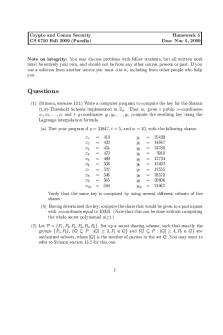Seminar Assignments - Kurt Spreyer, Espm 50Ac, Spring 2016, 9 PDF

| Title | Seminar Assignments - Kurt Spreyer, Espm 50Ac, Spring 2016, 9 |
|---|---|
| Author | Isai Rea |
| Course | Introduction To Culture And Natural Resource Manage... |
| Institution | University of California, Berkeley |
| Pages | 1 |
| File Size | 64.5 KB |
| File Type | |
| Total Downloads | 31 |
| Total Views | 132 |
Summary
Kurt Spreyer, ESPM 50AC, Spring 2016...
Description
Rea 1 Isai Rea Professor Kurt Spreyer ESPM 50AC March 14, 2016 Weekly Reflection- 9 In the year 1832, the Tierra Amarilla Land Grant was created by the Mexican government for settlers to move to the area in a mixture of private and communal land. The original Treaty of Guadalupe Hidalgo included Article X, which stated, “U.S. government would honor and guarantee all land grants awarded in lands ceded to the U.S. to citizens of Spain and Mexico by those respective governments” (Tierra o Muerte). However, the U.S. government eliminated Article X from the final treaty and the land rights held by the people of New Mexico were revoked. In 1950, the Hispanos living in this area furious over their loss of land petitioned the courts to reclaim their communal land but were revoked. The Hispanos in all their furry, outraged, resorted to illegal activity and civil disobedience in an attempted to protest for their land loss, none of which was beneficial. The Hispanos only managed to portray themselves in a ruthless manner and their claims ignored by these agitated forms of resistance that could have been handled in a more passive way. A pivotal player in the fight to restore the New Mexican land grants is Reies Lopez Tijerina, who turned into one of the most prominent activists of the Chicano Movement in the 1960s and 1970s. Tejerina is most notably known for the formation of the Alianza Federal de Mercedes and the raid on Rio Arriba County Courthouse in 1967 (Tierra o Muerte). The assault on the courthouse lead by Tejerina and members of the Alianza are some of the drastic measures the Hispanos took in an attempt to resist, protest and seek redress. The raid on the courthouse resulted shots were fired injuring two men; the district of attorney was arrested and “put on trial”. The whole event lasted until the National Guard came in and Tijerina was tracked down by the FBI down south with the two hostages he took (Tierra o Muerte). I admire the determination of Tijerina and agree that this bold moved brought publicity and attention to the issue of Hispano land loss in New Mexico. A risky move on Tijerina’s part to attempt the raiding of the U.S. Courthouse; however, history teaches us that sometimes bold and drastic measures are required to express one’s grievances ( Shay’s Rebellion (1786)). However, there is a negative feedback loop to this method of aggression and civil disobedience. The Anglos now have the ability to claim that the Hispanos are criminals and antagonizing the peace and freedom of Anglos in New Mexico. The negative image that Tijerina brought upon himself diminished his credibility and that of the Hispanos claims. Although noble in the attempt, Tijerina went to the extreme where he not only managed to draw attention to their cause, but instill a violent and criminalistics perspective on the Hispanos. The New Mexico land grants of the Tierra Amarilla were contested deeply over in the mid-twentieth century. Reies Tijerina and other Hispanos who formed the Alianza Federal de Mercedes raided a courthouse to voice their issues. Although noble in the attempt, the drastic measures taken by Tijerina were counterintuitive that brought a negative connotation to the cause and fight for redress in of land grants in New Mexico....
Similar Free PDFs

Seminar assignments - Quiz 9
- 7 Pages

ESPM 50ac Lecture Notes Unit 1
- 17 Pages

Seminar assignments
- 3 Pages

Seminar assignments
- 11 Pages

Seminar assignments - Assignment 15
- 11 Pages

Seminar assignments - Tax shield
- 1 Pages

Seminar assignments - Skew test
- 3 Pages

Seminar assignments ass1-14
- 2 Pages

Seminar assignments - everest report
- 15 Pages

Seminar assignments - Homework 5
- 1 Pages

Seminar assignments - report#1
- 3 Pages

Seminar assignments - And solutions
- 50 Pages
Popular Institutions
- Tinajero National High School - Annex
- Politeknik Caltex Riau
- Yokohama City University
- SGT University
- University of Al-Qadisiyah
- Divine Word College of Vigan
- Techniek College Rotterdam
- Universidade de Santiago
- Universiti Teknologi MARA Cawangan Johor Kampus Pasir Gudang
- Poltekkes Kemenkes Yogyakarta
- Baguio City National High School
- Colegio san marcos
- preparatoria uno
- Centro de Bachillerato Tecnológico Industrial y de Servicios No. 107
- Dalian Maritime University
- Quang Trung Secondary School
- Colegio Tecnológico en Informática
- Corporación Regional de Educación Superior
- Grupo CEDVA
- Dar Al Uloom University
- Centro de Estudios Preuniversitarios de la Universidad Nacional de Ingeniería
- 上智大学
- Aakash International School, Nuna Majara
- San Felipe Neri Catholic School
- Kang Chiao International School - New Taipei City
- Misamis Occidental National High School
- Institución Educativa Escuela Normal Juan Ladrilleros
- Kolehiyo ng Pantukan
- Batanes State College
- Instituto Continental
- Sekolah Menengah Kejuruan Kesehatan Kaltara (Tarakan)
- Colegio de La Inmaculada Concepcion - Cebu



